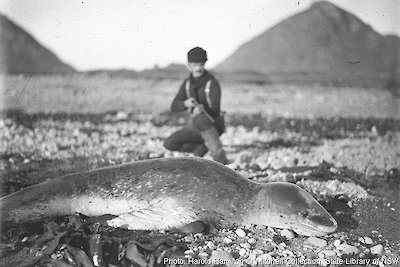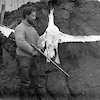Collecting the specimens
Hamilton recorded sightings and where possible collected examples of different animal and plant species. He recorded and described 34 vascular plant species (three of them endemic), and built a collection of eggs of virtually all the island’s bird species.
Hamilton also studied the life history and ecology of the world’s largest seal, the southern elephant seal. From the stomach contents of animals he reported cephalopods and (to a lesser extent) fish. But apart from the odd excursion in the inter-tidal zone he was unable collect marine specimens until September 1912, when Rachel Cohen delivered a dinghy, which he used for collecting and transporting specimens whenever the weather was calm enough.
The specimens were crucial to future studies back home. Hamilton was especially proud of his eggs and ‘a splendid collection of skins’, as Mawson described them later. But the effort was threatened by the discovery of damage by rats and mildew in the Isthmus storage, resulting in him having to overhaul the whole collection and re-prepare some of the skins.
Another collector came ashore during the two winters: Edgar Waite, Curator of the Canterbury Museum in Christchurch. He twice visited the island from Aurora for short visits from May to July 1912, and again in August 1913 during the Tutanekai relief visit.
The methods used by Hamilton, Waite and others to collect specimens are in stark contrast to those used today.



